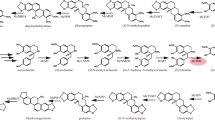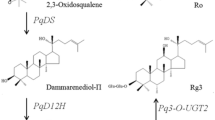Abstract
Madagascar periwinkle (Catharanthus roseus) produces many therapeutically valuable terpenoid indole alkaloids (TIAs), such as vinblastine and vincristine derived from the monomers vindoline and catharanthine. Deacetylvindoline-4-O-acetyltransferase (DAT) is a key enzyme for the terminal step of vindoline biosynthesis. In this research, the DAT gene promoter was cloned, sequenced, and analyzed. An approximately 1,773 bp genomic DNA fragment of DAT promoter was obtained. Sequence analysis revealed that DAT promoter contained several potential regulatory elements which were involved in the regulation of gene expression. To investigate its function, the promoter fragments with 5′ deletions and gain-of-function deletions were fused to GUS reporter gene, and their expressions were analyzed by transient expression in C. roseus cell suspensions. The regulatory activity of DAT promoter was identified with fluorescence quantitative assays. Three TGACG motifs and one inverted motif (CGTCA) between −808 and −1,086 bp in the DAT promoter were found to be involved in methyljasmonate signal transduction pathway.





Similar content being viewed by others
Abbreviations
- DAT:
-
Deacetylvindoline 4-O-acetyltransferase
- TIAs:
-
Terpenoid indole alkaloids
- GUS:
-
β-Glucuronidase
- MeJA:
-
Methyljasmonate
- MUG:
-
4-Methylumbelliferyl-β-d-glucuronide
- 4-MU:
-
4-Methylumbelliferone
References
Benfey PN, Ren L, Chua NH (1989) The CaMV 35S enhancer contains at least two domains which can confer different developmental and tissue-specific expression patterns. EMBO J 8:2195–2202
Boter M, Ruíz-Rivero O, Abdeen A, Prat S (2004) Conserved MYC transcription factors play a key role in jasmonate signaling both in tomato and Arabidopsis. Genes Dev 18:1577–1591
Brown RL, Kazan K, McGrath KC, Maclean DJ, Manners JM (2003) A role for the GCC-box in jasmonate-mediated activation of the PDF1.2 gene of Arabidopsis. Plant Physiol 132:1020–1032
Eilert U, De Luca V, Kurz WGW, Constabel F (1987) Alkaloid formation by habituated and tumorous cell suspension cultures of Catharanthus roseus. Plant Cell Rep 6:271–274
Guerineau F, Benjdia M, Zhou DX (2003) A jasmonate-responsive element within the A. thaliana vspl promoter. J Exp Bot 54:1153–1162
Higo K, Ugawa Y, Iwamoto M, Korenaga T (1999) Plant cis-acting regulatory DNA elements(PLACE) database. Nucleic Acids Res 27:297–300
Jefferson RA, Kavanagh TA, Bevan MW (1987) GUS fusions: beta-glucuronidase as a sensitive and versatile gene fusion maker in higher plants. EMBO J 6:3901–3907
Joshi CP (1987) An inspection of the domain between putative TATA-box and translation start site in 79 plant genes. Nucleic Acids Res 15:6643–6653
Kim SR, Choi JL, Costa MA, An G (1992) Identification of G-box sequence as an essential element for methyl jasmonate response of potato proteinase inhibitor II promoter. Plant Physiol 99:627–631
Kim SR, Kim Y, An G (1993) Identification of methyl jasmonate and salicylic acid response elements from the nopaline synthase (nos) promoter. Plant Physiol 103:97–103
Kim Y, Buckley K, Costa MA, An G (1994) A 20 nucleotide upstream element is essential for the nopaline synthase (nos) promoter activity. Plant Mol Biol 24:105–117
Lescot M, Déhais P, Thijs G, Marchal K, Moreau Y, Van de Peer Y, Rouzé P, Rombauts S (2002) PlantCARE, a database of plant cis-acting regulatory elements and a portal to tools for in silico analysis of promoter sequences. Nucleic Acids Res 30:325–327
Mason HS, DeWald DB, Mullet JE (1993) Identification of a methyl jasmonate-responsive domain in the soybean vspB promoter. Plant Cell 5:241–251
Menke FL, Champion A, Kijne JW, Memelink J (1999) A novel jasmonate-and elicitor-responsive element in the periwinkle secondary metabolite biosynthetic gene Str interacts with a jasmonate- and elicitor-inducible AP2-domain transcription factor, ORCA2. EMBO J 18:4455–4463
Omidvar V, Siti Nor Akmar A, Marziah M, Maheran AA (2008) A transient assay to evaluate the expression of polyhydroxybutyrate genes regulated by oil palm mesocarp-specific promoter. Plant Cell Rep 27:1451–1459
Pasquali G, Goddijin OJ, de Waal A, Verpoorte R, Schilperoort RA, Hoge JH, Memelink J (1992) Coordinated regulation of two indole alkaloid biosynthetic genes from Catharanthus roseus by auxin and elicitors. Plant Mol Biol 18:1121–1131
Rouster J, Leah R, Mundyt J, Cameron-Mills V (1997) Identification of a methyl jasmonate-responsive region in the promoter of a lipoxygenase 1 gene expressed in barley grain. Plant J 11:513–523
Schindler U, Beckmann H, Cashmore AR (1992) TGA1 and G-box binding factors: two distinct classes of Arabidopsis, leucine zipper proteins compete for the G-box-like element TGACGTGG. Plant Cell 4:1309–1319
Sobajima H, Tani T, Chujo T, Okada K, Suzuki K, Mori S, Minami E, Nishiyama M, Nojiri H, Yamane H (2007) Identification of a jasmonic acid-responsive region in the promoter of the rice 12-oxophytodienoic acid reductase 1 gene OsOPR1. Biosci Biotechnol Biochem 71:3110–3115
St-Pierre B, Laflamme P, Alarco AM, De Luca V (1998) The terminal O-acetyltransferase involved in vindoline biosynthesis defines a new class of proteins responsible for coenzyme A-dependent acyl transfer. Plant J 14:703–713
St-Pierre B, Vazquez-Flota FA, De Luca V (1999) Multicellular compartmentation of Catharanthus roseus alkaloid biosynthesis predicts intercellular translocation of a pathway intermediate. Plant Cell 11:887–900
Suttipanta N, Pattanaik S, Gunjan S, Xie CH, Littleton J, Yuan L (2007) Promoter analysis of the Catharanthus roseus geraniol 10-hydroxylase gene involved in terpenoid indole alkaloid biosynthesis. Biochim Biophys Acta 1769:139–148
Turner JG, Ellis C, Devoto A (2002) The jasmonate signal pathway. Plant Cell 14:153–164
Van der Fits L, Memelink J (1997) Comparison of the activities of CaMV 35S and FMV 34S promoter derivatives in Catharanthus roseus cells transiently and stably transformed by particle bombardment. Plant Mol Biol 33:943–946
Van der Fits L, Memelink J (2000) ORCA3, a jasmonate-responsive transcriptional regulator of plant primary and secondary metabolism. Science 289:295–297
Van der Fits L, Memelink J (2001) The jasmonate-inducible AP2/ERF-domain transcription factor ORCA3 activates gene expression via interaction with a jasmonate-responsive promoter element. Plant J 25:43–53
Vom Endt D, Soares e Silva M, Kijne JW, Pasquali G, Memelink J (2007) Identification of a bipartite jasmonate-responsive promoter element in the periwinkle ORCA3 transcription factor gene which interacts specifically with AT-hook DNA-binding proteins. Plant Physiol 144:1680–1689
Wasternack C, Stenzel I, Hause B, Hause G, Kutter C, Maucher H, Neumerkel J, Feussner I, Miersch O (2006) The wound response in tomato-role of jasmonic acid. J Plant Physiol 163:297–306
Acknowledgments
The authors thank Dr. Lingjian Wang from Shanghai Institute of Plant Physiology and Ecology for the help with GUS activity assay. This work was supported by China National High-Tech “863” Program (2007AA10Z189), “973” Program (2007CB108805), China Transgenic Research Program (2008ZX08002-001), Shanghai Science and Technology Committee (08391911800), and Shanghai Leading Academic Discipline Project (B209).
Author information
Authors and Affiliations
Corresponding author
Additional information
Communicated by W. Harwood.
Rights and permissions
About this article
Cite this article
Wang, Q., Yuan, F., Pan, Q. et al. Isolation and functional analysis of the Catharanthus roseus deacetylvindoline-4-O-acetyltransferase gene promoter. Plant Cell Rep 29, 185–192 (2010). https://doi.org/10.1007/s00299-009-0811-2
Received:
Revised:
Accepted:
Published:
Issue Date:
DOI: https://doi.org/10.1007/s00299-009-0811-2




